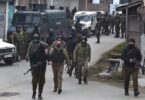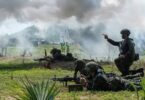India commenced a major tri-service (Army, Navy, and Air Force) combat exercise named 'Trishul 2025' (also called 'Mahagurjar') along the western border, in October 2025 in the area of Sir Creek and the Rann of Kutch marshlands. Trishul, meaning trident is Lord Shiva’s divine weapon symbolizing power and famously known as the weapon Shiva used to destroy evil forces.
India's Operation (Op) Sindoor in May 2025, began as an unprecedented meticulously planned high tech and high precision 88-hour series of combat actions which pulverised nine terror groups’ camps/headquarters and destroyed or rendered unserviceable at least eighteen major military assets (eleven photographed and declared by India and seven more not backed by photographs declared by Pakistan) inside Pakistan and Pakistan and Pakistan occupied Kashmir (PoK).
Sir Creek came into focus in October 2025 due to heightened military tensions between India and Pakistan, following Pakistan's military infrastructure expansion in that area. On October 2, 2025, Indian Defence Minister Rajnath Singh, while celebrating Vijayadashami with troops in Bhuj, Gujarat, issued a strong warning to Pakistan, stating that any "misadventure" in the Sir Creek area would invite a "decisive response that will change both history and geography". He also remarked that "a route to Karachi passes through the Creek", signalling India's readiness to act decisively. The Defence Minister virtually inaugurated a Tidal Independent Berthing Facility and a Joint Control Centre in the strategic creek sector, enhancing India's coastal security coordination and rapid response capabilities.
The creek originally known as Baan Ganga (Baan means arrow and Ganga is the sacred river) was renamed as Sir Creek during the colonial era after a British official who surveyed the area. Sir Creek refers to a 96-km tidal estuary in the uninhabited marshlands of the Rann of Kutch, which forms the border between India’s Gujarat state and Pakistan’s Sindh province. The location of Sindh is historic due to its central role in the ancient Indus Valley Civilization and its strategic importance throughout various empires, including those of Alexander the Great, the Arabs, and the British. Indus is a corruption of the original /actual name Sindhu, from which Sindh emanates.

Sir Creek one of Asia's largest fishing grounds, is believed to contain untapped oil and gas reserves, and is an ecologically sensitive zone. Its location also has major implications for defining each country's Exclusive Economic Zone (EEZ) in the Arabian Sea, impacting maritime security and resource rights. Located near the Rann of Kutch, which Pakistan attacked in the 1965 India-Pakistan war, its control is crucial for maritime security and surveillance. It is a key location for controlling border infiltrations and has been a site of security concerns. For Pakistan, control over the region is important for the defence of Karachi, its major economic hub. The marshy estuary is one of Asia's largest and most productive fishing grounds, supporting the livelihoods of thousands of fishermen from both countries. The area is also believed to hold significant untapped reserves of oil and gas beneath the seabed, a resource highly sought after for energy security. The final boundary line at Sir Creek directly impacts how much of the Arabian Sea each country can claim for its EEZ, affecting exclusive rights to fishing and resource extraction. An ecologically sensitive area, it is a home to flamingos and other migratory birds, making it important for biodiversity conservation.
Intelligence reports indicated that Pakistan was increasing its military presence near the Sir Creek region, including constructing new bunkers, observation posts, and logistics facilities, which raised red flags in India. After the hard beatings that Pak army and air force have taken during those 88 hours in May, the possibility of them being delusional enough to plan yet another misadventure cannot be ruled out.
Both nations issued temporary flight restrictions (NOTAMs) during the period, indicating high alertness and parallel military activities on both sides of the border.
India’s aim of the 12-day exercise from October 30 till November 10, 2025, is for significantly projecting military readiness for safeguarding territories and deterring potential threats. The exercise will test the Indian armed forces' preparedness for offensive and defensive operations, simulating strikes into southern Pakistan and practicing joint combat drills across diverse terrains.
Key assets deployed for the operation include over 20,000 soldiers, T-90 and Arjun battle tanks, BrahMos missile units, Akash missile defence system units from the Army; Rafale and Sukhoi Su-30 fighter aircraft, Prachand attack helicopters, and Sea Guardian and Heron drones from the Air Force and Kolkata-class destroyers and Nilgiri-class frigates from the Navy.
India's massive military drill has led to a significant response from the Pakistani side. Pakistan shut down many sectors of its airspace by expanding its existing NOTAMs just hours before the Indian exercise was set to begin. This was in response to a NOTAM issued by India restricting its own airspace—up to a ceiling of 28,000 feet—over central India, including the crucial air traffic hubs of Nagpur, Bhopal, and Indore, for the duration of Ex Trishul.
Further demonstrating heightened alert, Pakistan scrambled its fighter jets from three key bases—Shorkot, Risalpur, and Mianwali—conducting multiple sorties early on 30 October morning, just minutes before India's NOTAM for "Trishul" was activated. This immediate reaction highlights the strategic impact and perceived threat of the massive Indian tri-service mobilization near the western border.
Headquarters Western Naval Command, in close coordination with the three Services, will be conducting the exercise which will feature large scale operations across the creek and desert sectors of Rajasthan and Gujarat, alongside comprehensive maritime operations including amphibious operations in the North Arabian Sea. The Indian Navy’s aircraft carrier will be operating jointly with shore-based assets of the Indian Air Force. Covering the Gujarat coast and the northern Arabian Sea - Army Southern Command, Western Naval Command, and the South Western Air Command are the principal formations participating in the exercise - Indian Coast Guard, Border Security Force, and other central agencies are also participating in large numbers, further reinforcing inter-agency coordination and integrated operations.
The exercise aims to achieve validation and synchronisation of operational procedures across the three Services, enabling joint effect-based operations in multi-domain environment. Key objectives include enhancing interoperability of platforms and infrastructure, strengthening the integration of networks across Services, and advancing jointness in operations across multiple domains.
A major focus of the exercise is also to enhance synergy between all forces and validate multi-domain integrated operations in a large and complex operational environment, involving large scale deployment of Indian Navy warships, Indian Air Force fighter and support aircraft, as well as amphibious operations involving amphibious component of Indian Army and Indian Navy including the Landing Platform Dock INS Jalashwa and Landing Craft Utility vessels (LCUs).
The exercise will also (a) validate joint intelligence, surveillance and reconnaissance (ISR), electronic warfare (EW) and cyber warfare plans; (b) highlight the effective employment of indigenous systems made in India and making the Armed Forces self-reliant; (c) will focus on the refinement of procedures and techniques evolved to deal with emerging threats and raise consciousness about contemporary and future warfare; (d) raise the collective resolve of all the three services to operate in a fully integrated manner, thereby enhancing joint operational readiness and national security preparedness and (e) integrate some of the central armed police forces and other required agencies/organisations.
There are two major reasons for the necessity of conducting Ex Trishul. The first is that while Op Sindoor was brilliantly conducted, it was mainly high tech. It must be followed by a well-planned and coordinated series of procedures and actions on the land, on and below the sea and in the air by all personnel involved.
The second reason is strategic signalling to the world and in particular to our adversaries, that we have the capability and also, as amply proved by Op Sindoor, the political will to implement whatever we need to do to for our security and sovereignty. While Trump continues his troublesome tantrums and tariffs and may not at all be happy about Ex Trishul, his government’s defense secretary has signed a 10-year defence deal with India’s defence minister on 31 October 2025. Since Op Sindoor onwards, Prime Minister Narendra Modi and External Affairs Minister S. Jaishankar have very clearly and consistently conveyed to the US that India cannot be treated as a pushover or as an inferior. While India’s performance in Op Sindoor was a rude shock to the US, Ex Trishul may give a few more shocks.
While many countries have lined up for purchasing Indian weaponry after Op Sindoor, following Ex Trishul, there may be even more.
To Pakistan, particularly to its delusional military leadership, the message should be very clear that it must not attempt any more misadventures in any part of India and from any direction.
The author a strategic affairs analyst and former spokesperson, Defence Ministry and Indian Army, can be contacted at wordsword02@gmail.com, https://www.linkedin.com/in/anil-bhat-70b94766/ and @ColAnilBhat8252, https://www.youtube.com/channel/UCPJKaZOcAt9K8fcDkb_onng
More on related topics:
Pakistan Issues NAVAREA IX 514/25 for Naval Live-Fire Drills as India Conducts Trishul 2025 in Arabian Sea: https://www.thestrategicperspective.org/pakistan-issues-navarea-9-514-25-for-naval-live-fire-drills-as-india-conducts-trishul-2025-in-arabian-sea/
India's Substantial Missile Programme: https://www.thestrategicperspective.org/indias-substantial-missile-programme/
The United States–India 10-Year Defence Framework Agreement: https://www.thestrategicperspective.org/the-united-states-india-10-year-defence-framework-agreement/
Pakistan and Egypt Strengthen Defence Cooperation as Pakistan Army Chief Asim Munir Visits Cairo: https://www.thestrategicperspective.org/pakistan-and-egypt-strengthen-defence-cooperation-as-pakistan-army-chief-asim-munir-visits-cairo/
INS Trikand’s Mediterranean Mission: Debunking the Turkish “Ultimatum” Story: https://www.thestrategicperspective.org/ins-trikands-mediterranean-mission-debunking-the-turkish-ultimatum-story/










